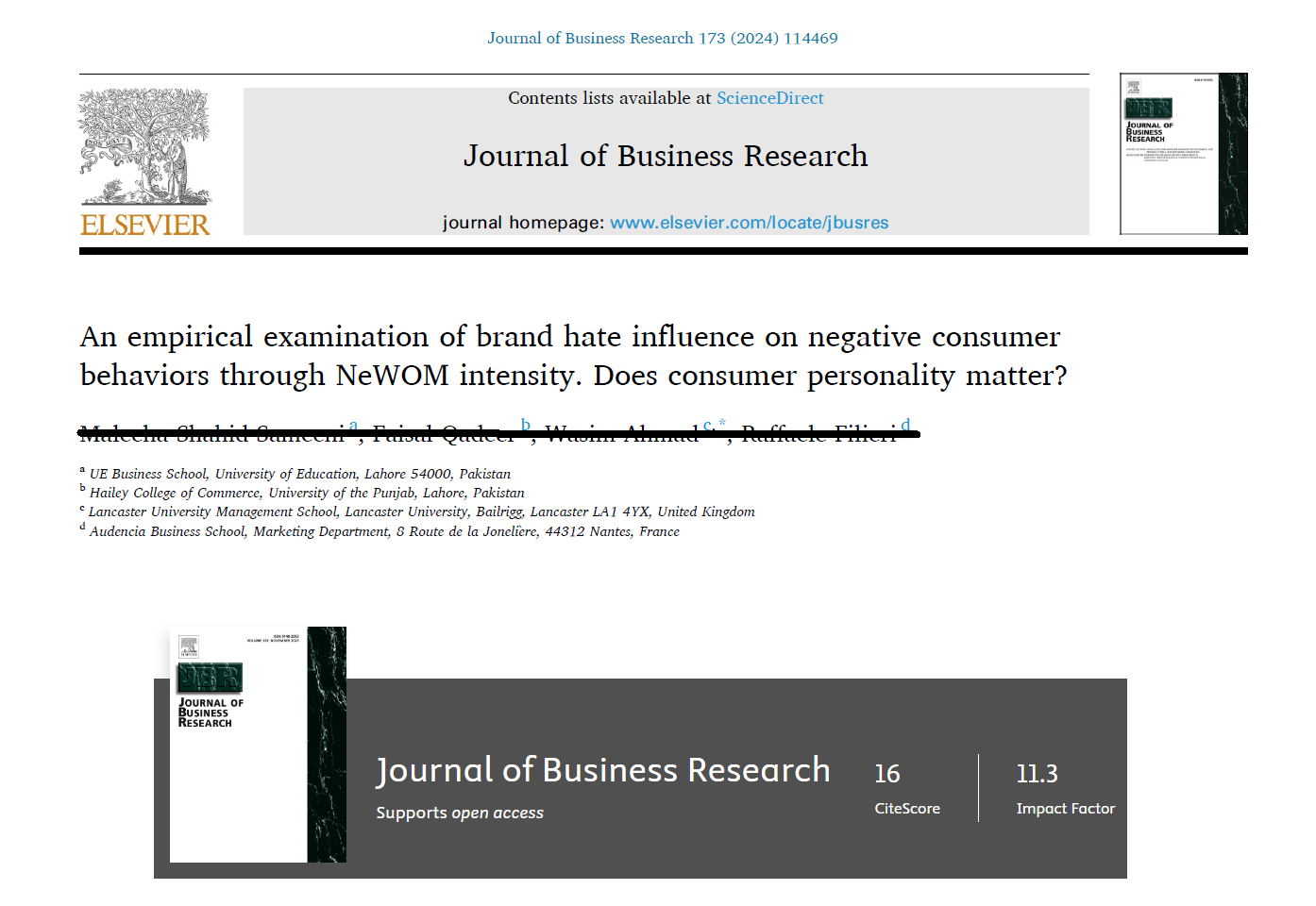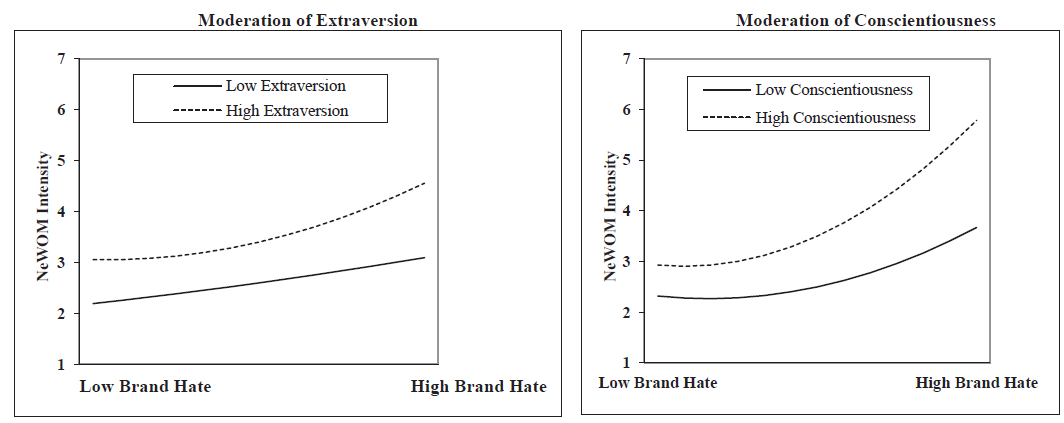Published on: 1 January, 2024
It has become a harsh reality that Editors and Reviewers of many so-called high impact journals completely overlook many significant issues and mistakes commonly found in published business articles. In fact, it is the prime responsibility of Editors to enforce Authors not to commit major mistakes even if Reviewers ignore them. In such cases, sometimes, Editors put the burden of responsibility on Reviewers or vice versa. This question is also significant as to why authors make such mistakes as most of the authors are either established academicians holding a PhD degree or Doctoral students who conduct and report research in the supervision of established academicians.

Today, we will indicate a strong instance of published business research where Editors and Reviewers completely failed to identify and rectify many unacceptable bloopers. The article “An empirical examination of brand hate influence on negative consumer behaviors through NeWOM intensity. Does consumer personality matter?” authored by Sameeni et al. (2024) is published in the “Journal of Business Research” which is a Clarivate (SSCI - Impact Factor for 2022: 11.3) and Scopus (Q1) Business Journal. The journal is charging a hefty amount of money i.e., USD 3780 for open access articles.
Our first objection is the absence of Research Question(s) in the Introduction section. The authors didn’t formulate RQ(s) this paper was going to address. If there are no RQs, the questions on scientific methods of formulating RQs are useless.
Let’s start to analyze the Literature Review. On page 5 (Table 1) the authors mentioned that they applied Equity theory, Self-enhancement theory, General aggression model, and Big Five personality Model to support their study framework. However, strangely, no theoretical underpinnings were explicitly reported in the Literature Review. To generate Hypothesis 1, authors merely wrote “Drawing on equity theory (Adams, 1963), we state that…” (p. 6), which is not enough to underpin the hypothesized relationship. Authors should give a detailed account on how Brand hate is positively related to NeWOM intensity in the light of Adams’ equity theory?


We don’t know whether we are going in the right direction or not but it is obvious that Adams’ equity theory of motivation (1963) explains that employees who make contributions (inputs) at the workplace want fair rewards (outputs), and similar (equity) to those received by their peers. If they think that rewards are fair, they get motivated or vice versa. The Adams’ equity theory deals with employee-employer relationships, where work compensations and rewards are always involved. We have no idea how this theory can be applied to customers/brand users, and to conjecture the relationship between Brand Hate and NeWOM. If an extension of the said theory is available then the authors should have reported it.
To propose the second hypothesis (p. 6), Authors mention “We base on self-enhancement theory (Swann et al., 1987)…” We know that self-enhancement theory is a meta-theory based on various personality and learning theories. Jones (1973) mentions that individuals with negative self-concepts lack self-esteem, therefore, they try to compensate for the lack of self-esteem by enhancing their self-views more than their counterparts with high self-esteem. In contrast, people with positive self-views endeavor to maintain their views. Swann et al. (1987) provide a comparison of self-consistency theorists and self-enhancement theorists. They noted that former believe that individuals with negative self-concept prefer negative feedback, whereas latter believe that such people prefer positive feedback to enhance their self-views. Based on the above arguments, hypothesis 2 is, somehow, contrary to the strong form of self-enhancement theory. We would question, how the Authors determined the positive or negative self-concept status of the brand users? If the sample was low in positive self-concept or had negative self-concept, why did they adopt negative behaviors?

We have the same observations regarding mediation hypotheses. There are no underpinning theories reported to support mediation hypotheses.
In the section dealing with personality traits as moderators, the Authors dealt extraversion and neuroticism at the same level. They proposed that extraversion and neuroticism (here we are not talking about other traits) will moderate the relationships between IVs/DVs reflecting negative tendencies. We know that extraversion and neuroticism are 180 degrees out of phase, therefore, we can’t expect similar outcomes emerging from both traits. Literature doesn’t associate extraversion with negative tendencies and outcomes. We think the authors made a serious mistake here. To associate extraversion with harmful behaviors such as consumer-brand sabotage, the author just cited one reference i.e., Harris and Ogbonna (2002). Only based on this single citation, the authors associated other harmful behaviours i.e., service brand hate, NeWOM intensity, and consumer boycott with extraversion. If we read Harris and Ogbonna (2002), we will learn that these authors associated extraversion with service sabotage in a proposition. This proposition was framed on the basis of just one interview with a supervisor of a company plus citing studies on antisocial and counterproductive behaviors i.e., Giacalone and Greenberg (1997); Kolz (1999). If we study Kolz (1999) to further verify the claim, we are surprised that Kolz (1999) didn’t include extraversion in their study of counterproductive behaviors.
Let’s start to analyze the methodology of this paper. The paper reports that a total of 395 responses were received but we have no information on how many single informant surveys were disseminated? As the Authors mention “For the primary survey, a panel of consumers from the United Kingdom was recruited via Prolific…” (p. 8). The readers want to know how many total participants were recruited on the panel who did and didn’t experience brand hate. Due to this missing information, we can’t see the response rate, and hence, no information on non-response bias is provided. In addition, use of single informant surveys demands to report tests for common method bias (CMB) but we can’t find.

On page 8, sub-section “Sample size adequacy”, authors mention ““entrenched camps” arguing to look at total sample size (minimum sample sizes) or tehe ratios (number of cases required per item, N:p ratio)…” We really have no idea what does “tehe ratios” mean? Surely, this is a spelling mistake left uncaught by the Editors.

The Authors mentioned “In structural equation modeling (SEM), a factor analysis-based technique…” (p. 8), but they didn’t inform either they used CB-SEM or PLS-PM and which software was used to conduct the analysis. Giving a look at the reported results, it makes us clear that the Authors used CB-SEM (probably using AMOS) because they reported model fit indices (p. 10). Strangely, they reported t-values for hypotheses testing which are used in PLS-PM but not in CB-SEM. CB-SEM uses C.R to test the signficance. Altering the AMOS's original C.R labels with t-statistics is deceptive becasue C.R and t-statistic are theoretically different techniques.
We can see that the Authors didn’t report the study variables’ Descriptive Statistics, so, we are unable to see the real response of the sample. In addition, Pearson’s Correlations were also not provided which is strange. The authors reported Betas and t-values/p-values to affirm the proposed hypotheses, however, Standard Errors (SEs) are missing. We know how important SEs are in PLS-PM and CB-SEM type analyses. We wonder why Editors and Reviewers didn’t detect and force the Authors to provide a lot of missing information.
Finally, as a reader of the article, we want to know why all moderation plots are showing non-linear relationships between independent/dependent variables and moderators. We know that moderation analysis assumes a linear relationship between independent/dependent variable and moderator. Even if, due to some reasons, the Authors got nonlinear results, why didn't they explain in the text?

Don’t forget to comment to reflect your thoughts on the orignal article and our criticism.
Adams, J. S. (1963). Towards an understanding of inequity. Journal of Abnormal and Social Psychology, 67(5): 422–436.
Jones, S. C. (1973). Self-and interpersonal evaluations: Esteem theories versus consistency theories. Psychological Bulletin, 79, 185–199.
Kolz, A. R. (1999). Personality Predictors of Retail Employee Theft and Counterproductive Behavior. Journal of Professional Services Marketing, 19(2): 107-114.
Swann, W. B., Griffin, J. J., Predmore, S. C., & Gaines, B. (1987). The cognitive–affective crossfire: When self-consistency confronts self-enhancement. Journal of Personality and Social Psychology, 52(5): 881-889.
Update: On 2 January, 2024, Dr. Faisal Qadeer (second Author) contacted the "Scholarly Criticism" through commenting platform and acknowledged the issues raised by the "Scholarly Criticism" and felt regret for making the identified mistakes.
"Scholarly Criticism" is launched to serve as a watchdog on Business Research published in so-called Clarivate/Scopus indexed high quality Business Journals. It has been observed that, currently, this domain is empty and no one is serving to keep authors and publishers of journals on the right track who are conducting and publishing erroneous Business Research. To fill this gap, our organization serves as a key stakeholder of Business Research Publishing activities.
For invited lectures, trainings, interviews, and seminars, "Scholarly Criticism" can be contacted at Attention-Required@proton.me
Disclaimer: The content published on this website is for educational and informational purposes only. We are not against authors or journals but we only strive to highlight unethical and unscientific research reporting and publishing practices. We hope our efforts will significantly contribute to improving the quality control applied by Business Journals.
